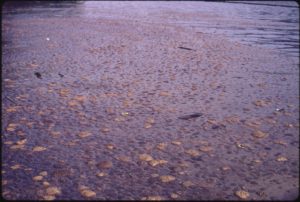
Close up view of polluted water on the Ohio River near Pittsburgh (via John L. Alexandrowicz)
When you set out on a road trip, the first thing you do is find your starting point on a map and set a destination.
Watershed groups use a similar approach for restoration projects. First, they establish a starting point: how bad is the pollution and what’s causing it?
Then, they set a destination using what’s called a Total Maximum Daily Load – or TMDL.
Bill Brown of the Pennsylvania Department of Environmental Protection says a TMDL outlines how much pollution the waterway can handle and still meet clean water goals.
Brown explains “TMDL’s serve as planning tools that provide the target and give some insight into the major pollutant sources.”
…helping answer the question – ‘are we there yet?
Get Schooled:
- Learn more about TMDLs from the Pennsylvania DEP
- Find more info on the EPA TMDL page.
- Find the TMDL for your local waterway using this tool from the EPA
Hear More:
Bill Brown of the Pennsylvania DEP how TMDL’s facilitate water restoration in PA.
Watch more:
Explanation of what TMDLs are and how they are determined (via Minnesota River Expert):
The fine print:
- This segment was produced in partnership with Cornell’s Atkinson Center for a Sustainable Future and made possible by the Foundation for Pennsylvania Watersheds.




